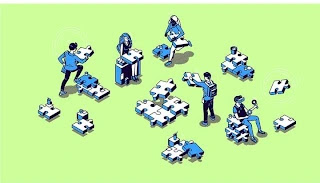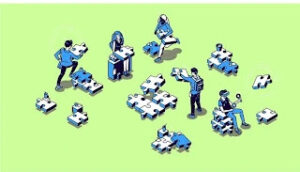How To Easily Finish A Large Project By Dividing It Into Small Parts
Many times we have to work on big projects. Working on such projects is seen where many large tasks have to be completed within a certain time frame. And you can become disoriented under this pressure.
How To Easily Finish A Large Project By Dividing It Into Small Parts
Such feelings hinder the progress of work. Because it can demoralize and sometimes it becomes impossible to finish the work. When it seems impossible to complete a task, the task is basically neglected.
But have you ever thought about breaking down a big project or task into smaller parts as per your ability?
It is actually more like eating a lot of food in front of you. Similarly, no matter how big or difficult a task is, if it is divided into small parts, the task can be completed.
Once you break it down into smaller parts, it becomes much easier to complete the whole task. So do as much as you can in the moment rather than doing the whole thing at once. Knowing how to break down a large task into smaller tasks will make your work more productive. And the amount of work will also increase.
How To Divide Large Tasks Into Smaller Parts
Before breaking a large task into smaller parts, you need to know what the total work means. It sounds easy to think, but you can’t plan well if you don’t know what action means.
Since you need to draft your work, breaking it down into smaller pieces is difficult. Also, how you break down a large task into smaller parts determines how long you want them to take.
For example, let’s say writing an e-mail is a task. Now you can shorten the work in a few steps. For example, the e-mail should be written to Aman Sahib, and the e-mail should contain a discussion about the project’s deadline. Now you can easily understand how to complete the task.
But writing e-mail is not big enough as a task. On the other hand, breaking down big tasks like creating a presentation into smaller parts is helpful. To do that, let’s learn about a technique called “Rewind and Reduce”.
Rewind And Reduce Technique
If you’ve ever broken down a task into smaller chunks to increase productivity and efficiency, you’ve probably noticed that there are many different ways to do it. These methods will help you learn to divide work into smaller parts.
Maybe all such methods are very useful. But not every method may work well for you.
For those who want to increase their productivity and reach their goals, the ‘rewind and reduce’ method can work. In this way you can reduce your big work nicely and finish the work well within a certain time frame.
Once you get used to this method, you may not look for another way to break down tasks and increase productivity.
Let’s make it clear with an example. Let’s say if someone takes 8 hours to make a presentation before taking the help of ‘Rewind and Reduce’ method, then with this method he can make the presentation in two hours. In addition, his mental stress will also decrease. Again he will be able to complete tasks without much effort.
To understand the ‘Rewind and Reduce’ method we need to discuss the following steps.
• Step 1: Rewind
In the first step our strategy is to ‘rewind’. Simply put, it is starting from the end. The goal of this step is to start working from the point where you want to reach the end of the work. In this way you will easily find the main goal of the work. At the same time, you can complete the work on time.
Every project has some goal, be it increasing sales, improving business operations, reducing costs or increasing customer satisfaction.
A clear understanding of work goals will help you and your team work together more easily and increase productivity. In one study, 162 people participated in a test called the ‘hand-eye coordination test’. Hand-eye coordination test is basically a simple test. The participant is asked to first throw a tennis ball towards the wall with the right hand and catch it with the left hand. Then he is asked to throw his left hand and catch it with his right hand. This continues for a certain period of time.
The researchers found in the experiment that there was a link between the participants’ specific goals and performance. Research has shown that people who have specific goals are more productive.
That is, the goal of a large project should be such that you can find the right way of working from it. Starting from scratch after setting a specific goal will save you time and energy.
For example, let’s say a manager is thinking of making a presentation to fix the way the whole organization works. Now the things to prioritize when starting from scratch: decide who the audience is, brainstorm and choose a good topic. Also planning the presentation, extensive research to find important information sources and finally practice well before giving the presentation.
• Step Two: Reduce
The first step will help you find the goals you need to complete the task successfully. This second step is called ‘Reduce’. This step involves breaking down each important topic into smaller parts. To divide into small parts means to focus on a particular topic. Care should be taken to divide the tasks into small parts so that they can be completed in at least one hour.
Then decide how much time you want to spend on each task. The smaller the task, the more easily and accurately it can be completed.
• Step Three: Summary
The third step is to put all your plans together so that you can complete the task within the specified time frame. For example, let’s say you have to finish a presentation by next Friday. And in the third step, he analyzed and saw that if he works for one hour every day, he can finish the presentation well. Think of the whole thing like this:
1. Planning the presentation and proceeding from a properperspective: 1 hour
2. Extensive research to find sources of important information: 1 hour
3. Prepare slides for presentation in a clear and concise manner: 1 hour
4. Practice in presenting well: 30 minutes
5. Total time will be 3 and a half hours.
If you plan like this, you will have to start work on Tuesday. And then the work can be completed by Friday without any stress. Very simple, right?
Conclusion
A large project can take weeks, months, or even years to complete. And frustration can set in if too much time and energy is spent on a project. And even after completing the project, it may seem like a waste of energy and time, which has turned into a disappointment. And that’s exactly why you can use the ‘rewind and reduce’ method to break down your big project into smaller parts.
While finishing a big project, everyone’s mind is filled with worry. So breaking a big task into smaller parts like this is beneficial for everyone. Especially if you have a habit of procrastinating, breaking large tasks into smaller parts can help.


